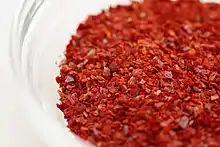| Korean chili pepper | |
|---|---|
 Green chili peppers | |
| Species | Capsicum annuum |
| Origin | Korea |
| Heat | |
| Scoville scale | 1,500 SHU |
Korean chili peppers or Korean hot peppers, also known as Korean red,[1] Korean dark green,[2] or Korean long green[3] peppers according to color (ripening stages), are medium-sized chili peppers of the species Capsicum annuum. The chili pepper is long, slender and mild in flavor and spice. Green (unripe) chili peppers measure around 1,500 Scoville heat units.[4]
Names
In Korean, the chili peppers are most often called gochu (고추), which means "chili pepper".[5] Green ones are called put-gochu (풋고추),[6] and red ones are called hong-gochu (홍고추).
Introduction to Korea
Chili peppers, which originated in the Americas, were introduced by Portuguese traders to Korea, via Japan, in the late 16th century.[7][8][9] The first mention of chili pepper in Korea is found in Collected Essays of Jibong, an encyclopedia published in 1614.[10][11] Farm Management, a book from around 1700, discussed the cultivation methods of chili peppers.[12]
Culinary use
| Korean chili powder | |
 Gochugaru (chili powder) | |
| Korean name | |
|---|---|
| Hangul | 고춧가루 |
| Revised Romanization | gochut-garu |
| McCune–Reischauer | koch'ut-karu |
Gochugaru, also known as Korean chili powder,[13][14] is chili powder or flakes used in Korean cuisine.[15] The name gochugaru is derived from Korean gochutgaru, where gochu (고추) means 'chili pepper' and garu (가루) means 'powder'.[16][5][17] In English, gochugaru usually refers to the seedless, Korean variety of chili powder. It has a vibrant red color, the texture may vary from fine powder to flakes, and the heat level from mildly hot to very hot.[18][19] Traditionally made from sun-dried Korean red chili peppers (태양초, taeyang-cho), gochugaru has a complex flavor profile with spicy, sweet, and slightly smoky tastes.[18] Gochugaru made from Cheongyang chili peppers is finer and hotter.
Gallery
 Red (ripe) chili peppers
Red (ripe) chili peppers Green (unripe) chili peppers
Green (unripe) chili peppers Harvested green chili peppers
Harvested green chili peppers Red chili peppers tied with saekki (straw ropes)
Red chili peppers tied with saekki (straw ropes) Dried red chili peppers
Dried red chili peppers
See also
References
- ↑ Kim, Suna; Park, Jaebok; Hwang, In Kyeong (January 2004). "Composition of Main Carotenoids in Korean Red Pepper (Capsicum annuum, L) and Changes of Pigment Stability During the Drying and Storage Process". Journal of Food Science. 69 (1): FCT39–FCT44. doi:10.1111/j.1365-2621.2004.tb17853.x.
- ↑ Newcomb, Karen (2015). The Postage Stamp Vegetable Garden: Grow Tons of Organic Vegetables in Tiny Spaces and Containers. New York: Ten Speed Press. p. 133. ISBN 978-1-60774-683-6. Retrieved 10 July 2018.
- ↑ Reddy, K. Madhavi; Shivashankara, K. S.; Geetha, G. A.; Pavithra, K. C. (2016). "Capsicum (Hot Pepper and Bell Pepper)". In Rao, N. K. Srinivasa; Shivashankara, K. S.; Laxman, R. H. (eds.). Abiotic Stress Physiology of Horticultural Crops. New Delhi: Springer. doi:10.1007/978-81-322-2725-0_9. ISBN 978-81-322-2723-6. Retrieved 10 July 2018.
- ↑ Baek, Sangkyung (16 March 2017). "[Consumer Journal] 辛맛에 빠진 대한민국". Maeil Business Newspaper (in Korean). Retrieved 10 July 2018.
- 1 2 "gochu" 고추. Korean–English Learners' Dictionary. National Institute of Korean Language. Retrieved 27 July 2017.
- ↑ "put-gochu" 풋고추. Korean–English Learners' Dictionary. National Institute of Korean Language. Retrieved 28 August 2018.
- ↑ Guide to Korean Culture: Korea's cultural heritage (2015 ed.). Seoul: Korean Culture and Information Service, Ministry of Culture, Sports and Tourism. 2015 [1995]. pp. 131–133. ISBN 9788973755714.
- ↑ Park, Jae Bok (Spring 1999). "Red Pepper and Kimchi in Korea" (PDF). Chile Pepper Institute Newsletter. Vol. 8, no. 1. p. 3. Retrieved 20 March 2017.
- ↑ Marianski, Stanley; Marianski, Adam (2012). Sauerkraut, Kimchi, Pickles & Relishes. Seminole, FL: Bookmagic. p. 45. ISBN 9780983697329.
- ↑ Hui, Y. H.; Ghazala, Sue; Graham, Dee M.; Murrell, K. D.; Nip, Wai-Kit, eds. (2004). Handbook of Vegetable Preservation and Processing. New York: Marcel Dekker. pp. 190–191. ISBN 978-0824743017.
- ↑ Yi, Sugwang. Jibong yuseol 지봉유설(芝峯類說) [Topical Discourses of Jibong] (in Korean). Joseon Korea – via Wikisource.
- ↑ Hong, Manseon. Sallim gyeongje 산림경제(山林經濟) [Farm Management] (in Literary Chinese). Joseon Korea. Archived from the original on 2017-03-28 – via DB of Korean classics by ITKC.
- ↑ Collins, Glenn (4 December 2012). "Sandwiches for Sandy Relief". The New York Times. Retrieved 27 July 2017.
- ↑ Khaleeli, Homa (22 October 2013). "A global guide to pickles". The Guardian. Retrieved 27 July 2017.
- ↑ Lamuye, Adebola (7 July 2017). "5 must-try Korean dishes". Evening Standard. Retrieved 27 July 2017.
- ↑ "Gochutgaru" 고춧가루. Korean-English Learners' Dictionary. National Institute of Korean Language. Retrieved 27 July 2017.
- ↑ "Garu" 가루. Korean-English Learners' Dictionary. National Institute of Korean Language. Retrieved 27 July 2017.
- 1 2 Smith, Kat (8 March 2017). "Gochugaru: The Hot, Sweet, Smoky Red Pepper Powder That is the Taste Behind Many Korean Foods". One Green Planet. Retrieved 28 July 2017.
- ↑ Ried, Adam (17 February 2017). "Recipes: Korean soups with choose-your-adventure spiciness". The Boston Globe. Retrieved 27 July 2017.